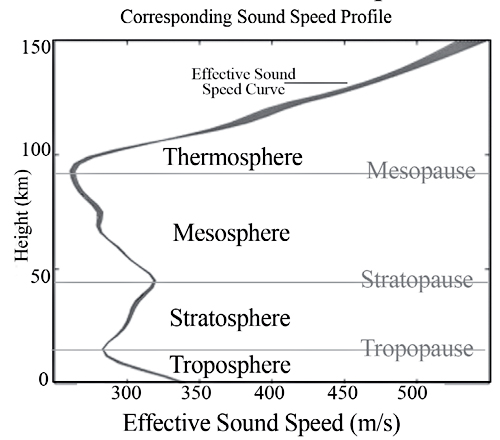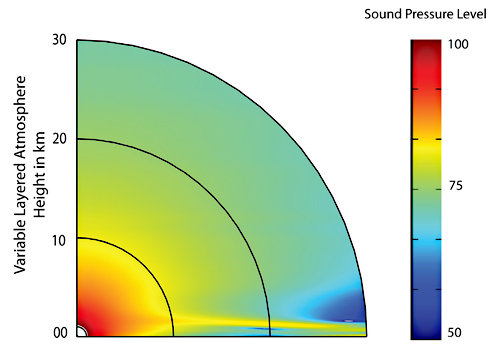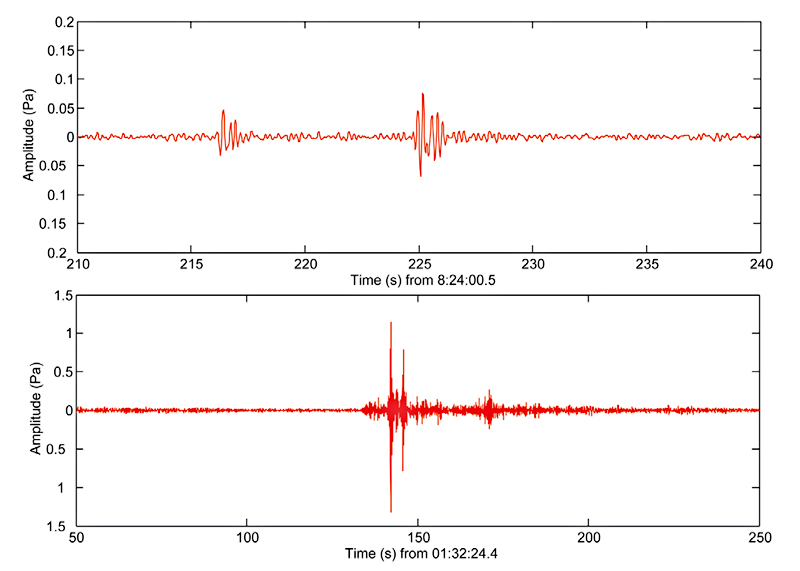Using FEM for Infrasound Propagation 有限元方法模拟声波传播 by Dr. Mihan H. McKenna, Research Geophysicist, US Army Engineering R&D Center, Vicksburg, Miss Thursday, July 08, 2010 ShareThis undefined Generally classified as sound between 0.05 and 20 Hz, infrasound cannot be heard by humans, but can be detected on specialized sub-audible microphones which operate on the principle of a vibrating pressure field generating recordable electronic impulses. Classical infrasound monitoring focuses on source-to-receiver distances greater than 250 km, where more recent infrasound monitoring research has focused on distances closer than 150 km, bridging the distance between long-range acoustics and true infrasound monitoring.  The Columbia Space Shuttle on takeoff.(Photo courtesy of NASA)Traditionally, parabolic equation (PE) methods have been developed for the numerical solution of long range (>500 km) infrasound propagation in a layered atmosphere. This technique can be powerful for long range propagation due to its simple numerical implementation and limited use of computational resources. PE techniques are analogous to frequency wave number investigations in observed data, predicting how trapped energy and spherical wave front phenomena interact not only in arrival times but also in the attenuation of the observed amplitude. The PE method approximates the wave equation by modeling energy propagation along a cone oriented in a preferred direction. This approximation provides reasonable accuracy over long propagation distances. However, for short-range propagation (<50 km), the mathematical formulations used in the PE method break down and do not provide sufficient accuracy needed for precise measurements and predictions. Structure of the Atmosphere The Columbia Space Shuttle on takeoff.(Photo courtesy of NASA)Traditionally, parabolic equation (PE) methods have been developed for the numerical solution of long range (>500 km) infrasound propagation in a layered atmosphere. This technique can be powerful for long range propagation due to its simple numerical implementation and limited use of computational resources. PE techniques are analogous to frequency wave number investigations in observed data, predicting how trapped energy and spherical wave front phenomena interact not only in arrival times but also in the attenuation of the observed amplitude. The PE method approximates the wave equation by modeling energy propagation along a cone oriented in a preferred direction. This approximation provides reasonable accuracy over long propagation distances. However, for short-range propagation (<50 km), the mathematical formulations used in the PE method break down and do not provide sufficient accuracy needed for precise measurements and predictions. Structure of the Atmosphere An idealized atmospheric structure with a linear trend in the troposphere. An idealized atmospheric structure with a linear trend in the troposphere.To produce high-fidelity propagation modeling coupled to complex source functions, the author worked with Dr. Kyle Koppenhoefer and Dr. Jeffrey Crompton of AltaSim Technologies to develop ?nite element method (FEM) based acoustic solutions, such as those implemented in COMSOL Multiphysics software, to accurately represent the propagation of acoustic waves without the approximations in the PE method. These solutions can be used to provide accurate solutions for short range propagation acoustic waves where the PE method is not well suited. However, FEM methods require large computational resources (such as memory and CPU time) to solve long range propagation problems makng accurate solutions difficult. Thus, FEM and PE methods complement each other to solve the problem of infrasound propagation in layered atmospheres; FEM¬based solutions deliver accuracy in the short range and PE-based solutions accurately simulate behavior at large distances. To validate the use of COMSOL’s FEM acoustics code, we present two cases where the PE and FEM methods are evaluated. Infrasound propagationInfrasound propagation depends on the effective sound speed (Ceff) of the atmosphere through which it travels, so it is imperative to properly characterize the atmospheric conditions as close to the time and location of the propagation pathway as possible. The propagation pathways are governed by effective sound speed profiles, calculated by: Ceff= Ct+ n•v, where Ct ˜ 20.07(T)½, T is absolute temperature in Kelvin, and n•v is the component of wind speed in the propagation direction. Temperature is the dominant factor in calculating the effective sound speed; wind speed and direction are only secondary factors. In order for up-going infrasonic energy to be observed at Earth’s surface, it must reach an area of higher sound velocity than at the point of origin. If this occurs, the energy turns and then returns to the surface of the earth.How the atmosphere is quantified for data analysis and modeling depends on the particular areas of the atmosphere through which the infrasound propagates. For source-to-receiver paths of less than 200 km, local meteorological information is imperative to accurately characterize the propagation medium. Surface measurements are inadequate to properly characterize the whole height of the atmospheric profile through which the infrasound propagates. It is necessary to use radiosonde, weather balloon, or equivalent measurements for the temperature and wind profiles to create the Ceff used in modeling. Energy propogation pathways through the lower atmosphere for regional propogation at 2Hz  For distances greater than 200 km from the source to the receiver, the signal may travel through highly variable energy pathways that travel primarily through the upper atmosphere, the thermosphere, and propagate vast distances though a medium that changes little over the time span of months. Most of these sources are either large (such as energy from the Krakatoa volcano eruption in 1883, which reverberated around the world eight times before dying out), from substantial vertical seismic displacements from earthquakes, or occur in the upper atmosphere, such as meteorites. For distances greater than 200 km from the source to the receiver, the signal may travel through highly variable energy pathways that travel primarily through the upper atmosphere, the thermosphere, and propagate vast distances though a medium that changes little over the time span of months. Most of these sources are either large (such as energy from the Krakatoa volcano eruption in 1883, which reverberated around the world eight times before dying out), from substantial vertical seismic displacements from earthquakes, or occur in the upper atmosphere, such as meteorites.The tropospheric structure is sometimes governed by fast moving weather systems and is considerably more variable than the atmosphere above the tropopause. Short-lived temperature inversions can create ephemeral ducts with higher sound speed velocities than are found at the ground. Being able to accurately quantify these ducts in time and space is imperative for remote monitoring using infrasound by developing computational methods to effectively manage discontinuities and rapid changes in temperature and wind with altitude. Long-range infrasound propagationWorldwide infrasound arrays observe a variety of sources at variable distances. Earthquakes, volcanoes, mining explosions, and man-made atmospheric explosions are some of the most common signals observed on infrasound arrays, but bolides (meteors) and shuttle reentries are also recorded at very long propagation distances, hundreds to thousands of kilometers. Observations from supersonic atmospheric sources, such as space shuttle reentries, have been recorded on the infrasound arrays from initial installation and have been subject to intense study over the years. As early as1971, infrasound signals were observed from the Apollo space craft flights and recordings continue today. Comparison of short duration local events to long duration, long propogation path events.  Variable signal character between near-regional and longrange (tele-infrasonic)propagation pathwaysThe events of the February 1, 2003 Columbia space shuttle reentry failure provide the first case where an explosion at altitude has a known location in four dimensional space and time, as well as a characterized atmospheric pro?le in addition to being recorded on an infrasound array approximately 600 km away in Lajitas, Tex. The three dimensional shuttle path was recorded by NASA and the timing of the events that led to the disintegration was known; the trajectory and timing can then be combined with a well characterized atmospheric pro?le to produce a graphical representation of the paths the acoustic energy takes through the atmosphere. Variable signal character between near-regional and longrange (tele-infrasonic)propagation pathwaysThe events of the February 1, 2003 Columbia space shuttle reentry failure provide the first case where an explosion at altitude has a known location in four dimensional space and time, as well as a characterized atmospheric pro?le in addition to being recorded on an infrasound array approximately 600 km away in Lajitas, Tex. The three dimensional shuttle path was recorded by NASA and the timing of the events that led to the disintegration was known; the trajectory and timing can then be combined with a well characterized atmospheric pro?le to produce a graphical representation of the paths the acoustic energy takes through the atmosphere.Originally adapted from underwater acoustic studies, PE modeling provides a ?eld solution for a complete vertical plane at one frequency. An infrasound monitoring community standard PE code was compared in this effort, and it steps forward from a source and calculates an attenuation field for predicting amplitudes along the vertical slice. In using the PE codes, it is imperative that the computational atmosphere be deep enough to include all viable energy pathways. This depth of ?eld required for PE modeling is where the high accuracy advantage of FEM breaks down. One FEM solution for an atmospheric pro?le took ?ve days to run on a 16 GB quad core MacPro, for 0.25 Hz, and only propagated out to 200 km, rather than the full distance of 600 km. The results correlate well over the distances executed in the FEM model, bearing in mind the change in frequency content from 1 Hz to 0.25 Hz and associated change in wavelength. While accurate, the computational resources required to produce equivalent solutions to the PE codes at these distances indicate that the PE solutions would be more efficient. Short-range infrasound propagationAt shorter ranges, the advantage of COMSOL’s FE method is apparent. Recently, infrasound propagation over short range, less than 100 km, has become of greater interest. At long distances, such as the Columbia propagation pathways, the ?ne-scale source structure found in the propagating energy is smeared in the observed signal. At the shorter distances of 30 - 100 km, retaining source character becomes more important, as there is less smearing in the observed signal. COMSOL provides accurate solutions by solving the partial differential equation for acoustic wave propagation without the approximations used in the PE method. Thus, the full characteristics of the source will be included in the solution. Modeling sources as diverse as point explosions or structural emanations, the software supports integrating the source and propagation functions in the same model. This flexibility enables infrasound modeling of many conditions that were prev-iously difficult to solve. Thus, the software offers advantages beyond the additional accuracy found in the FEM solutions. It opens up the study of infrasound to a much broader range of sources while permitting the study of infrasound in the near field. The technology also provides the capability to develop transient and time-harmonic solutions. The transient solution most accu-rately represents short duration sources, such as point source explosions. The propagation of a 2 Hz signal over 30 km was produced using COMSOL’s Acoustics Module. The variation of sound speed through the layers of the atmosphere strongly influ-ences the propagation of this signal. When the atmospheric conditions are favorable the acoustic energy refracts to the Earth’s surface. The duct at approximately 2 km traps the acou-stic energy necessary to produce favorable likelihood for observing infrasound energy from source to receiver. While future research to optimize boundary conditions and mesh sizes to minimize run time and computational resources is ongoing, COMSOL’s Acoustic Module offers the long-range acoustics and near-regional infrasound monitoring community an effective tool to produce accurate, high-resolution propagation modeling for situations where integrating complex sources is important. COMSOLwww.comsol.com ::Design World:: |
分享到
豆瓣网
开心网
人人网
QQ书签
Google
3322个朋友已经阅读过这篇文章
用户评论
没有找到数据. , |